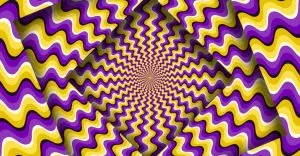If you have been to a science museum or an art gallery, or browsed social media, chances are you have come across an optical illusion. When your brain interprets an image in more than one way or in a way that is different from reality, you are experiencing an optical illusion. This blog will discuss how optical illusions work and how the brain perceives them.
What Is an Optical Illusion?
Light from our surroundings enters our eyes, activating cells in the retina (the back of the eye), which sends electrical signals along the optic nerve to the brain where an image is perceived. Normally the brain performs this job seamlessly, instantly providing us with accurate images of the world.
However, there are occasions when the brain is unsure of what it sees. Optical illusions occur when your eyes are presented with colors, lights, patterns, borders or areas of contrast that mislead the brain. It tries to piece together images using optical clues, learned assumptions and past visual experiences. In these cases, there is a difference between the reality of what you see and what your brain thinks you see. As a result, your brain makes a guess and is tricked into seeing something that does not exist, or it struggles to decide between alternating versions of an image.
Types of Optical Illusions
Optical illusions fall into three categories: physiological illusions, cognitive illusions and literal illusions.
Physiological Illusions
Physiological illusions occur when the brain’s visual system becomes overstimulated and confused by light, movement, shapes, colors, positions, or contrast. In the example below, the colors, shapes, and patterns give the appearance of movement, even though the image is static.

Cognitive Illusions
Cognitive illusions occur when your brain infers and attempts to understand what your eyes see based on prior assumptions about the world we live in. There are several subtypes of cognitive illusions, including ambiguous illusions, distorting illusions, fiction illusions and paradox illusions.
The Kanizsa triangle is one of the most common types of cognitive illusions. As shown in the photo below, the shapes and empty space in the middle are meant to trick the brain into thinking there is a triangle in the center of the image. However, there is no triangle. Instead, the objects are grouped together to give this appearance.
Literal Illusions
Literal illusions occur when two images are interpreted to look like one image. Your eyes view these images separately, but the brain interprets it as a single, fluid picture. For example, the literal illusion below depicts both an apple core (in white) and two people looking at each other (in black). The brain uses a “filling-in” phenomena, which occurs when it decides which part of the image to focus on, and how to interpret the empty space.

What Happens in Your Brain When You See an Optical Illusion?
Our eyes take in light from the environment. The retina translates this stimulus into electrical signals that move along neural pathways through the thalamus (a structure in the middle of the brain responsible for relaying sensory impulses) and to the brain’s visual cortex, located at the back of the head. Here, the information is processed in multiple stages that layer the different elements present in the information to build a three-dimensional image. This is sent to the prefrontal cortex, the part of the brain that decides how to respond to the image.
Researchers are finding, however, that there can be variation along this neural pathway that might help explain why or how we experience optical illusions. For instance, researchers at Carnegie Mellon University found that some of the signals that make it to the second stage of processing in the visual cortex are sent back to the first stage before final interpretation occurs.. This reprocessing might explain why we see the Kanizsa triangle, or other illusions, that are not actually there. Another study has shown that one other type of difference between perception and reality may occur in the superior temporal area, an area of the brain responsible for visual motion information, due to a slight processing gap of 15 milliseconds, which creates the illusion of motion.
Here are some more examples of how your eyes and brain react to stimuli to create optical illusions.
Color: The retina has three light and color sensitive cells called cones – red-sensing cones, green-sensing cones and blue-sensing cones. If you gaze at the same color for several seconds, prolonged stimulation desensitizes the retina. The cones temporarily stop responding. For example, you may stare at a red image long enough to where your brain perceives it as green. This is because the red cones stopped responding due to overstimulation.
Context: With optical illusions, your surroundings matter. Height is a common example. The average adult male is 5-feet, 9 inches tall. If you place someone of this height around a group of tall NBA players, that person will look tiny in comparison. Similarly, that same man would look taller if pictured with young children.
Brightness: Some optical illusions rely on brightness variations in the background to confuse the brain. For example, two gray dots of the same color on different backgrounds (one dark and one lighter) will appear to the viewer as different shades of gray. This is due to differing simultaneous brightness contrast occurring in the retina.
Shadows: Objects that cast shadows change the way your brain perceives light, which can make images appear paler than they actually are. Shading also provides information to the brain on whether images appear closer or farther from you.
Blinking dots: When your brain sees blinking dots, light receptors in your eyes become confused. As a result, you may picture dark spots that aren’t really there.
Selecting: It is much easier for your brain to focus on a single image at a time, so it may select one image when presented with two or more simultaneously.



